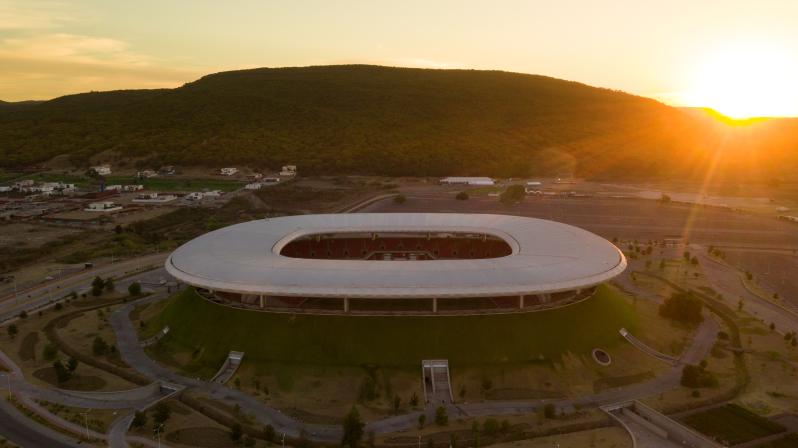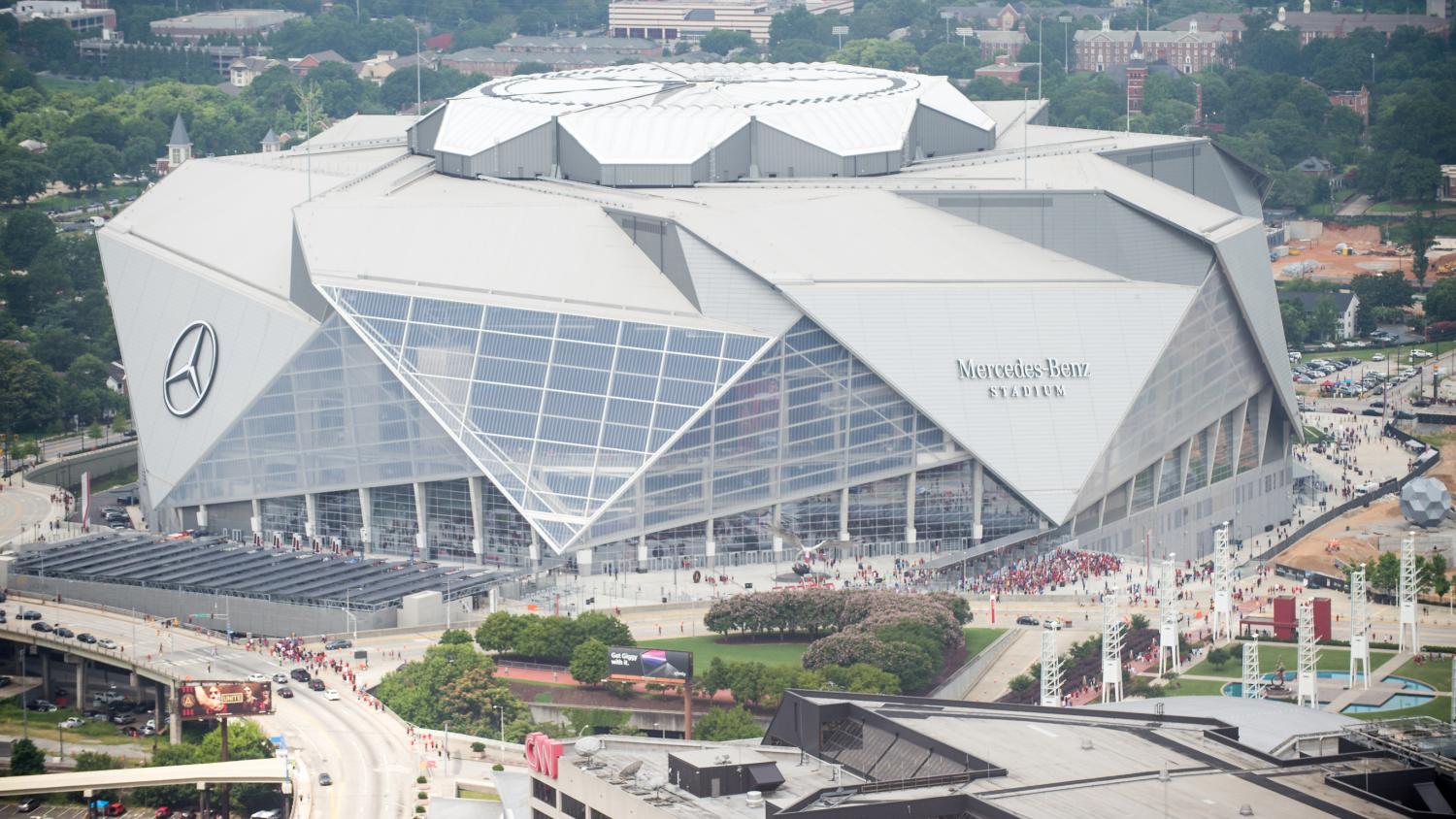From Mexico City to Vancouver, Los Angeles to New York, the men’s 2026 World Cup co-hosted by the United States, Mexico and Canada will be one of the greatest spectacles in the history of sport. It’s never too early to start looking ahead to the next World Cup, especially when it will be held in our backyard. Here’s a preview of all 2026 World Cup stadiums.
The men’s 2026 World Cup will be held in the summer of 2026 at 16 venues in three different countries. Three will be in Mexico, two in Canada and the remaining 11 in the U.S. FIFA announced the 2026 World Cup stadiums on June 16, 2022, leaving out bids from Edmonton, Denver, Cincinnati, Nashville, Orlando and D.C./Baltimore.
View this post on Instagram
Additionally, FIFA will soon determine which 2026 World Cup stadiums will host the opening match and final as well as other major matches. Los Angeles and Mexico City are in the running for the opener. Those two stadiums plus Mercedes-Benz Stadium, AT&T Stadium and MetLife Stadium are in the running to host semifinals and the final.
Below is a preview of the 2026 World Cup stadiums.
View this post on Instagram
Note: Capacities and other details listed are based on the numbers in the United 2026 bid book where available. The 2026 World Cup stadiums are listed in alphabetical order by country. Stage of competition is based on what the stadium bid to host.
All Men’s 2026 World Cup Stadiums
United States 2026 World Cup Stadiums
Arrowhead Stadium
- Location: Kansas City, Missouri
- Capacity: 76,640
- Year Constructed: 1972
- Pitch Dimensions: 105m x 68m
- Surface: Natural grass
- Stage of Competition: Quarterfinal/Third-Place Match
- Number of Toilets: 556 men, 564 women, 91 accessible
One of America’s most venerable venues, Arrowhead underwent a $375 million renovation in 2010 to bring it up to date with many of the new 2026 World Cup stadiums. Home to the NFL’s Kansas City Chiefs, Arrowhead was also once the home of the Kansas City Wizards, now Sporting KC.
The KC stadium has hosted the U.S. men’s and women’s national teams. Arrowhead owns the Guinness World Record for loudest stadium with 142.2 decibels recorded in a Chiefs-Patriots game in 2014.
AT&T Stadium
- Location: Arlington, Texas
- Capacity: 92,967
- Year Constructed: 2009
- Pitch Dimensions: 105m x 68m
- Surface: Artificial turf (will convert to grass for World Cup)
- Stage of Competition: Semifinal/Final
- Number of Toilets: 758 men, 759 women, 189 accessible
Nicknamed Jerry World — either a term of endearment or loathing depending on your view of the home team Dallas Cowboys — AT&T Stadium was built with hosting a World Cup final in mind. The $1.2 billion monument to excess is one of the most impressive buildings in the U.S.
Located in the Dallas suburb of Arlington, AT&T Stadium features a retractable roof and a ginormous video board that was the largest ever built at the time the stadium opened. In addition to housing the Cowboys of the NFL, the venue has hosted title games for NCAA football and basketball, an NBA All-Star Game, countless college football games and some international soccer matches. The first-ever sporting event at the stadium was a Gold Cup doubleheader that included Mexico beating Haiti 4-0.
Gillette Stadium
- Location: Foxborough, Massachusetts
- Capacity: 70,000
- Year Constructed: 2000
- Pitch Dimensions: 105m x 68m
- Surface: Hybrid (will use grass for World Cup)
- Stage of Competition: Semifinal
- Number of Toilets: 556 men, 390 women, 92 accessible
Foxborough, a suburb of Boston, is no stranger to the World Cup. Foxboro Stadium hosted five 1994 World Cup matches and five 1999 Women’s World Cup matches. Gillette Stadium hosted four 2003 Women’s World Cup matches and will now get its chance to host men’s World Cup games.
Gillette is home to the New England Revolution (MLS) and Patriots (NFL). The stadium Tom Brady made famous has a long soccer history beyond the World Cup, including a long list of Gold Cup matches and three in the Copa América Centenario.
Hard Rock Stadium
- Location: Miami, Florida
- Capacity: 67,518
- Year Constructed: 1987
- Pitch Dimensions: 105m x 68m
- Surface: Natural grass
- Stage of Competition: Quarterfinal/Third-Place Match
- Number of Toilets: Not available
Known by many names over its four decades in operation, Miami’s premier venue has gone by Hard Rock Stadium since a $500 million renovation in 2016, which added a roof to cover 90 percent of the seating.
In addition to hosting Super Bowls, World Series and NCAA football national title games, Hard Rock has some soccer history, as well. In 2017, it was the site of the first El Clásico played outside of Spain.
Levi’s Stadium
- Location: Santa Clara, California
- Capacity: 70,909
- Year Constructed: 2014
- Pitch Dimensions: 105m x 68m
- Surface: Natural grass
- Stage of Competition: Semifinal
- Number of Toilets: 687 men, 563 women, 125 accessible
One of the most technologically advanced and eco-friendly stadiums in the world, Levi’s Stadium will show the world what sustainability can look like in massive sports arenas. The first professional football stadium in the U.S. to become LEED Gold Certified, the home to the San Francisco 49ers has a farm on its roof.
As a sports venue, the Field of Jeans is one of the best in the world as well. The first game played was a San Jose-Seattle MLS match and the U.S. men’s and women’s national teams have used the stadium, including in the 2017 Gold Cup final.
Lincoln Financial Field
- Location: Philadelphia, Pennsylvania
- Capacity: 69,328
- Year Constructed: 2003
- Pitch Dimensions: 105m x 68m
- Surface: Natural grass
- Stage of Competition: Quarterfinal/Third-Place Match
- Number of Toilets: 879 men, 666 women, 135 accessible
From its very inception, the Linc has housed soccer, including a friendly between Barcelona and Manchester United in the stadium’s first-ever event. It also hosted four 2003 Women’s World Cup matches and many international matches over the years.
Lincoln Financial Field has improved sustainability over the years, implementing 11,000 solar panels and becoming a zero-waste facility to be LEED Silver Certified. The stadium also featured prominently in one of the best episodes of “It’s Always Sunny In Philadelphia.”
Lumen Field
- Location: Seattle, Washington
- Capacity: 69,000
- Year Constructed: 2002
- Pitch Dimensions: 105m x 68m
- Surface: Artificial turf (will convert to grass for World Cup)
- Stage of Competition: Quarterfinal/Third-Place Match
- Number of Toilets: 135 men, 436 women, 54 accessible
Home to one of the most passionate soccer fanbases in the country, Seattle’s Lumen Field will bring the men’s World Cup to the Pacific Northwest after the 1999 and 2003 Women’s World Cups played matches in Portland (Vancouver also hosted matches at the 2015 WWC).
Having replaced the iconic KingDome, Lumen Field (previously known as Qwest Field and CenturyLink Field) has become one of the best places in the U.S. to watch soccer every week, aided by a partial roof covering 70 percent of seats. Even better, you can buy Pacific salmon sandwiches, Dungeness crab cakes and local beers at the concessions.
Mercedes-Benz Stadium
- Location: Atlanta, Georgia
- Capacity: 75,000
- Year Constructed: 2017
- Pitch Dimensions: 105m x 68m
- Surface: Artificial turf (will convert to grass for World Cup)
- Stage of Competition: Semifinal
- Number of Toilets: 730 men, 811 women
This state-of-the-art stadium is home to Major League Soccer’s Atlanta United and the NFL’s Atlanta Falcons. Fans of the Five Stripes have turned MBS into one of the must-visit soccer venues in the U.S., proving an MLS expansion team can fill an NFL-sized stadium.
In its brief history, MBS has already hosted championships for the NFL, NCAA football and NCAA men’s basketball. The stadium’s wrap-around halo video board is the largest in professional sports (at the time of the bid) and the “pinwheel” retractable roof makes it one of the more unique venues at the World Cup.
MetLife Stadium
- Location: East Rutherford, New Jersey
- Capacity: 87,157
- Year Constructed: 2010
- Pitch Dimensions: 105m x 68m
- Surface: Artificial turf (will convert to grass for World Cup)
- Stage of Competition: Opener/Final
- Number of Toilets: 833 men, 611 women, 210 accessible
In the 1970s, Pelé filled the old Giants Stadium playing for the New York Cosmos. In the 1990s, Giants Stadium hosted 11 World Cup matches (seven men, four women). In 2026, the new MetLife Stadium will be one of the premier 2026 World Cup stadiums.
Though not technically in New York, MetLife Stadium is home to the New York Giants and New York Jets. It’s hosted countless soccer matches like the Gold Cup and Copa América Centenario plus club and international friendlies. A true mecca of sports stadia, the World Cup will be right at home at MetLife.
NRG Stadium
- Location: Houston, Texas
- Capacity: 72,220
- Year Constructed: 2002
- Pitch Dimensions: 105m x 68m
- Surface: Natural grass
- Stage of Competition: Quarterfinal/Third-Place Match
- Number of Toilets: 429 men, 506 women, 94 accessible
NRG Stadium is home to the NFL’s Houston Texans and replaced the iconic Astrodome as the Bayou City’s biggest venue when it became the first NFL stadium with a retractable roof in 2002. Additionally, NRG Stadium hosts the annual Houston Livestock Show and Rodeo, which is attended by about 2.5 million people per year.
NRG Stadium has been a favorite stopping point for both the U.S. and Mexico men’s national teams. Additionally, it’s hosted the NCAA men’s Final Four, the Super Bowl and an MLS All-Star Game.
SoFi Stadium
- Location: Inglewood, California
- Capacity: 70,240
- Year Constructed: 2020
- Pitch Dimensions: TBD
- Surface: Artificial turf (will convert to grass for World Cup)
- Stage of Competition: Opener/Final
- Number of Toilets: Not listed
Not yet built when the 2026 World Cup stadiums list was first drafted, SoFi Stadium opened in 2020 as one of the world’s most impressive structures. The state-of-the-art venue was ultimately chosen over the Rose Bowl.
SoFi hosted Super Bowl LVI in 2022 and is scheduled to host many more major events, including the 2028 Summer Olympics.
Canada 2026 World Cup Stadiums
BC Place
- Location: Vancouver, British Columbia
- Capacity: 54,500
- Year Constructed: 1983
- Pitch Dimensions: 107m x 69m
- Surface: Artificial turf (will convert to grass for World Cup)
- Stage of Competition: Round of 16
- Number of Toilets: Not listed
BC Place replaced Olympic Stadium in Montreal as the choice for Canada’s third 2026 World Cup stadium (Commonwealth Stadium in Edmonton was not selected). Home to the Vancouver Whitecaps, the stadium has already been on the world stage for the 2010 Winter Olympics and 2015 Women’s World Cup (it’s where Carli Lloyd scored her half-field goal against Japan).
BC Place has been through numerous renovations over the years, including the installation of a marvelous retractable roof that was part of a $150 million upgrade in 2008. Those changes were necessary after the ice accumulation tore previous inflatable roof.
BMO Field
- Location: Toronto, Ontario
- Capacity: 45,500
- Year Constructed: 2007
- Pitch Dimensions: 105m x 68m
- Surface: Natural grass
- Stage of Competition: Round of 16
- Number of Toilets: 210 men, 224 women, 31 accessible
Home to Toronto FC of MLS and the CFL’s Argonauts, BMO Field has hosted two U-20 World Cups and three MLS Cup finals, two of which featured the home side. The average attendance for Toronto FC matches regularly ranks in the upper echelon in MLS.
Although one of the newer stadiums in Canada, BMO had a $120 million makeover in 2015, adding 8,400 seats to increase capacity to 28,560. Further upgrades will raise seating to more than 45,000, the lower limit allowed for one of the 2026 World Cup stadiums.
Mexico 2026 World Cup Stadiums
Estadio Akron

Photo: Shutterstock
- Location: Zapopan, Jalisco (Guadalajara)
- Capacity: 48,071
- Year Constructed: 2010
- Pitch Dimensions: 105m x 68m
- Surface: Natural grass
- Stage of Competition: Round of 16
- Number of Toilets: 483 men, 357 women, 42 accessible
Home to Liga MX club Chivas Guadalajara, Estadio Akron is one of Mexico’s finest stadiums. The unique architecture is made to look like a volcano crowned by a cloud, emulating the nearby geography.
The first-ever match at Estadio Akron was a friendly between Chivas and Manchester United in which Javier Chicharito Hernández played a half for each team as part of his transfer to the English club. Later that year, the stadium hosted the 2010 Copa Libertadores final first leg.
Estadio Azteca
- Location: Tlalpan, Mexico City
- Capacity: 87,523
- Year Constructed: 1966
- Pitch Dimensions: 105m x 68m
- Surface: Hybrid (will use grass for World Cup)
- Stage of Competition: Opening Match
- Number of Toilets: 823 men, 204 women, 20 accessible
One of the great stadiums in world football, the Azteca has already hosted two World Cup finals, the only stadium that can make that claim. (The Maracanã held the 2014 final and the decisive match of the 1950 World Cup, but the 1950 competition did not have an actual final.)
At one time holding as many as 119,853 fans for a match, the seating has been reduced to 87,523 for safety reasons but remains a fortress for the Mexico national team and home to iconic Club América. It’s almost impossible to find a stadium with more history than the Azteca.
Estadio BBVA
- Location: Guadalupe, Nuevo León (Monterrey)
- Capacity: 53,460
- Year Constructed: 2015
- Pitch Dimensions: 105m x 68m
- Surface: Natural grass
- Stage of Competition: Round of 16
- Number of Toilets: 357 men, 255 women, 32 accessible
Estadio BBVA has been nicknamed El Gigante de Acero (The Steel Giant) for its sprawling silver roof. The venue has been the home for Liga MX’s Monterrey since opening in 2015.
The stadium is one of the newest, most advanced and most expensive stadiums in Mexico, and it was the first soccer stadium in North America to earn the LEED Silver Certification for its focus on sustainability and being eco-friendly.





